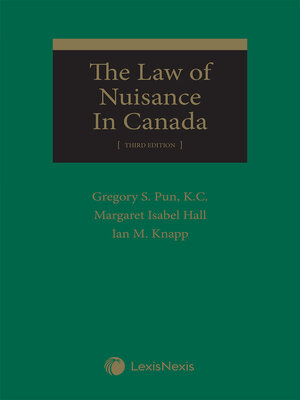
Sign up to save your library
With an OverDrive account, you can save your favorite libraries for at-a-glance information about availability. Find out more about OverDrive accounts.
Find this title in Libby, the library reading app by OverDrive.



Search for a digital library with this title
Title found at these libraries:
| Library Name | Distance |
|---|---|
| Loading... |
The Law of Nuisance in Canada, 3rd Edition provides a comprehensive review of the law of public and private nuisance and strict liability (Rylands v. Fletcher) as articulated and applied in Canadian case law.
Private nuisance is concerned with conflicting land uses, i.e. where a defendant uses their land in a way that interferes with a plaintiff's ability to "use and enjoy" land in which they have a property interest or right. Rylands v. Fletcher provides that a defendant who uses their land in a non-ordinary, high risk way may be strictly liable for damage caused to their neighbour's land. Public nuisance concerns an interference with the public's interest in health, safety, morality, comfort or convenience (for example, damage to waterways or interference with rights of public passage).
All three areas of law may be difficult to navigate. The meaning of "non-natural" and high risk (or "likely to do mischief on escape") in Rylands v. Fletcher has been the subject of much debate. The size and scope of "the public" for the purposes of public nuisance, and the kinds of interferences that will fall within it, may also be less than clear. Private nuisance is highly dependent on the factual context in a particular case. In this text, authors Gregory Pun, Margaret Hall and Ian Knapp identify and discuss the many common threads and basic statements of principle that do act as milestones and beacons within these nuanced areas of the law. The authors have used these basic guiding principles, as explained in and illustrated by current Canadian law, to help illuminate the way for others.
Features of This Book
- Determining whether a cause of action exists and the chances of success in pursuing it
- Assisting clients, such as advocacy and special interest groups, in furthering their goals through actions in nuisance (public and/or private) and Rylands v. Fletcher
What's New In This Edition
Who Should Read This Book







